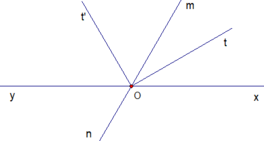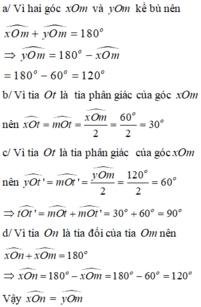Hãy nhập câu hỏi của bạn vào đây, nếu là tài khoản VIP, bạn sẽ được ưu tiên trả lời.

Bạn tự vẽ nha
Trên nửa mặt phẳng bờ chứa tia Ox,\(\widehat{xOt}< \widehat{xOy}\)(40o<80o)
Do đó tia Ot nằm giữa hai tia Oy và Ox (1)
Nên \(\widehat{xOt}+\widehat{yOt}=\widehat{xOy}\)
Hay\(40^o+\widehat{yOt}=80^o\)
\(\Rightarrow\widehat{yOt}=80^o-40^o=40^o\)
\(\Rightarrow\widehat{xOt}=\widehat{yOt}\left(=40^o\right)\)(2)
Từ (1) và (2)=>tia Ot là tia phân giác của góc xOy
Vì \(\widehat{xOm}\)kề bù vs\(\widehat{xOt}\)
\(\Rightarrow\widehat{xOm}+\widehat{xOt}=180^o\)
Hay \(\widehat{xOm}+40^o=180^o\)
\(\Rightarrow\widehat{xOm}=180^o-40^o=140^o\)
Vì On là tia phân giác của góc xOm
\(\Rightarrow\widehat{xOn}=\widehat{mOn}=\frac{\widehat{xOm}}{2}=\frac{140^o}{2}=70^o\)
\(\Rightarrow\widehat{mOn}=70^o\)

